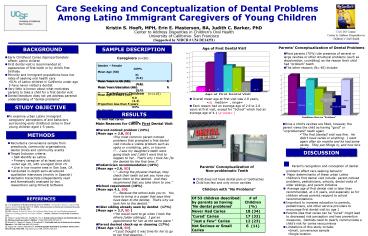STUDY OBJECTIVE - PowerPoint PPT Presentation
1 / 1
Title:
STUDY OBJECTIVE
Description:
To examine urban Latino immigrant caregivers' perceptions of and behaviors ... [2] DHF: Mommy, It Hurts To Chew: The California Smile Survey: An Oral Health ... – PowerPoint PPT presentation
Number of Views:97
Avg rating:3.0/5.0
Title: STUDY OBJECTIVE
1
Care Seeking and Conceptualization of Dental
Problems Among Latino Immigrant Caregivers of
Young Children
Kristin S. Hoeft, MPH, Erin E. Masterson, BA,
Judith C. Barker, PhD Center to Address
Disparities in Childrens Oral Health University
of California- San Francisco (Supported by NIDCR
U54 DE14251)
CAN DO Center Center to Address Disparities in
Childrens Oral Health
SAMPLE DESCRIPTION
Parents Conceptualization of Dental Problems
BACKGROUND
Age of First Dental Visit
- Most parents (70) cite presence of several or
large cavities or other structural problems (such
as discoloration, crumbling) as the reason their
child had problem teeth
- Early Childhood Caries disproportionately affects
Latino children - First dental visit is recommended at appearance
of first tooth or by childs first birthday - Minority and immigrant populations have low
rates of seeking oral health care - 51 of Latino children in California under age 5
have never visited a dentist - Very little is known about what motivates parents
to take a child for a first dental visit - Dental literature does not yet address parental
understanding of dental problems
Caregivers (n50)
Gender Female 100 Mean Age (SD) 31
(5.6) Mean Years in US (SD) 9
(5.8) Mean Years Education (SD) 9
(2.7) Mean Family Income 24,500 (12,700)
- The other reasons (N 46) include
Caregivers Children (n118)
Mean Age in Years (SD) 6.0 (4.2) Proportion
less than 5 years 63 insured 96
ever had caries 64
- Overall mean age at first visit was 2.8 years,
- sd, median , range
- Each reason had an average age of 2.6 to 2.8
years at first visit, except for School which
had an average age of 4.1 (p value )
STUDY OBJECTIVE
RESULTS
- To examine urban Latino immigrant caregivers
perceptions of and behaviors surrounding early
childhood caries in their young children aged 1-5
years.
Main Reasons for Childs First Dental Visit
- Once a childs cavities are filled, however, the
parent views the child as having good or
unproblematic teeth again - The first dental visit was fine. He didnt
have caries or anything. I went again after six
months and he had some caries. They put fillings
in, and now hes fine.
- Parent-noticed problem (24)
- Mean age 2.8, SD
- The most common parent noticed problems that
prompted a first dental visit include a visible
problem such as spots or crumbling, pain, or
trauma - I saw my daughters teeth were going black and
I didnt want that to happen to her. Thats why
I took her to the dentist for the first time. - Pediatrician recommendation (18)
- Mean age 2.6, SD
- during the physical checkup, they check their
teeth ad ask you have you taken them to the
dentist. And they recommend that you take them
to one. - School requirement (18)
- Mean age 4.1, SD
- Because the school asks you to. You have to
bring in a paper that says they have been to the
dentist. Thats why we took him to the dentist. - Older sibling already seen by dentist (17)
- Mean age 2.7, SD
- He would want to go when I took the others
older siblings. I got an appointment for him
at the same place. - Parent desired check-up or cleaning (17)
- Mean Age 2.8, SD
- I just thought it was time for her to go to her
first cleaning
METHODS
- Recruited a convenience sample from preschools,
community organizations, dental clinics and
community events - Target Inclusion criteria
- Self-identify as Latina
- Primary caregiver of at least one child under
age 10, with youngest child lt5 - Live in low income area in San Jose, CA
- Conducted in-depth semi-structured qualitative
interviews (mainly in Spanish) - Verbatim transcripts independently read and
thematically analyzed by two researchers using
NVivo Software
DISCUSSION
- Parents recognition and conception of dental
problems affect care seeking behavior - Major determinants of these urban Latino
childrens first dental visit include
parent-noticed problems, pediatricians, schools,
dental visits of older siblings, and parent
initiative - Average age of first dental visit is later than
recommended, at 2.8 years, and especially so for
children whose parents respond to school
recommendations - Important to increase education to parents,
pediatricians, and other service providers to
encourage first dental visit by age 1 - Parents idea that caries can be cured might
lead to decreased risk perception and less
prevention measures. Dentists need to clearly
communicate a childs risk for caries
reoccurrence - Limitations of this study include
- Small, convenience sample
- Single location
- Recall and social desirability biases
Parents Conceptualization of Non-problematic
Teeth
- Child does not have dental pain or toothaches
- Child has few and only minor cavities
Children with No Problems
REFERENCES
1 U.S. Department of Health and Human Services
(DHHS). Oral health in America a report of the
Surgeon General. Rockville, MD U.S. DHHS,
National Institute of Dental and Craniofacial
Research, National Institutes of Health, 2000 2
DHF Mommy, It Hurts To Chew The California
Smile Survey An Oral Health Assessment of
Californias Kindergarten and 3rd Grade
Children. Oakland, California Dental Health
Foundation 2006. 3 Nurko C, Aponte-Merced L,
Bradley EL, Fox L Dental caries prevalence and
dental health care for Mexican-American workers
children. J Dent Child 1998, 65(1)64-72. 4
Stewart DC, Ortega AN, Dausey D, Resenheck R
Oral health and use of dental services among
Hispanics. J Pub Hlth Dent 2002, 62(2)84-91. 5
Vargas CM, Crall JJ, Schneider DA
Sociodemographic distribution of pediatric dental
caries NHANES III, 1984-1988. J Am Dent Assoc.
1998, 129 (9) 1229-38 S































